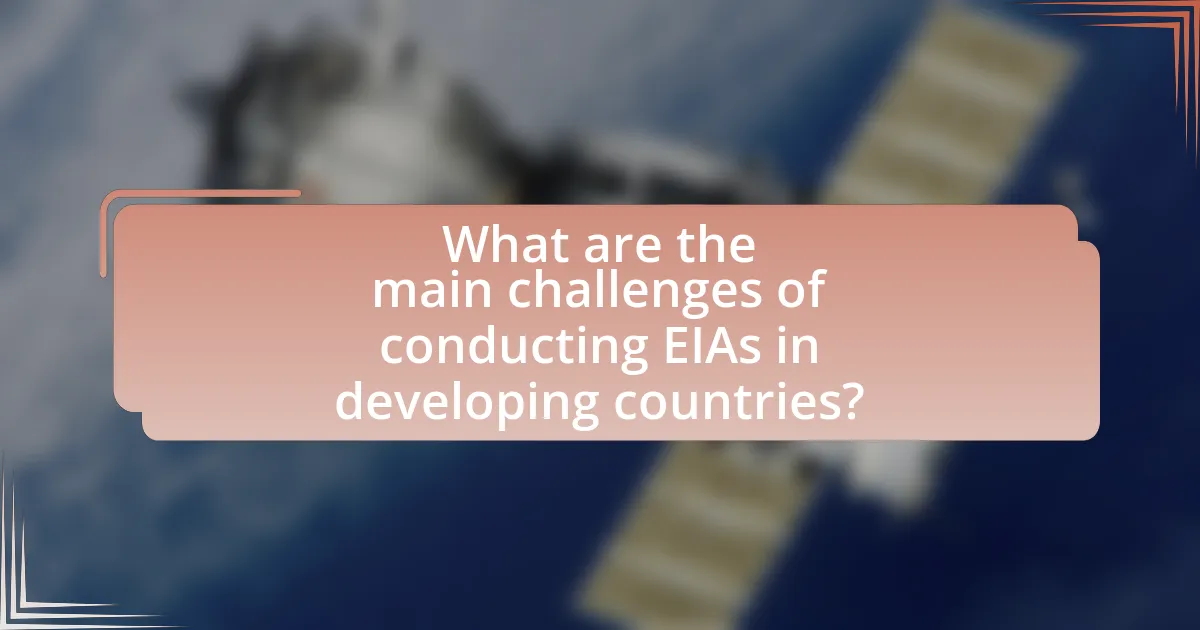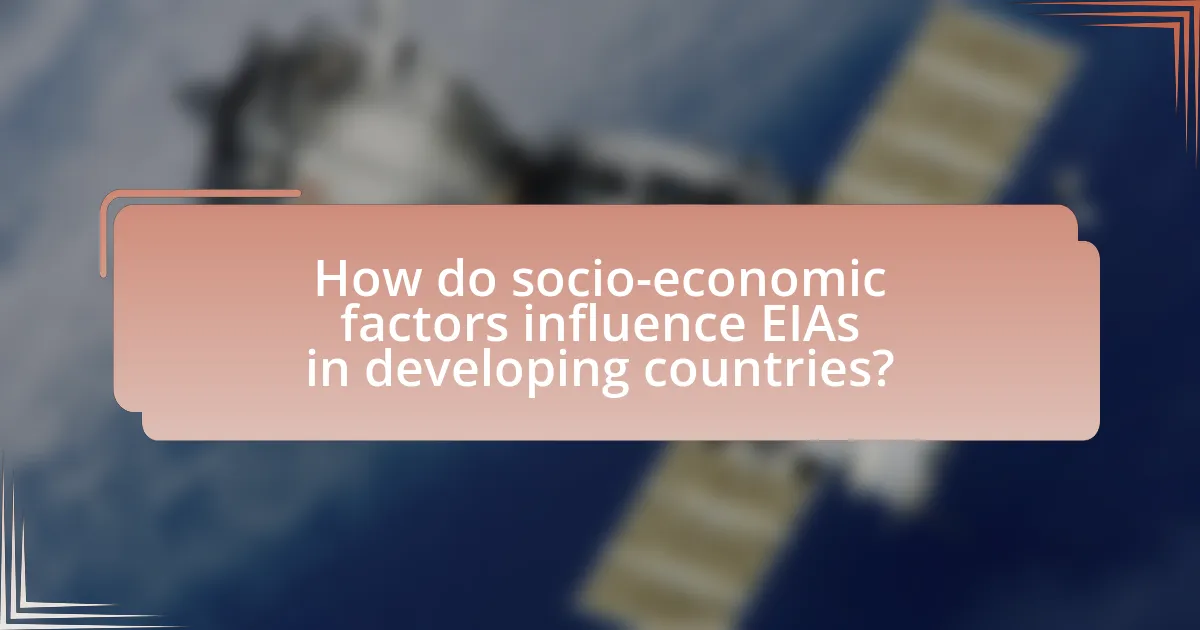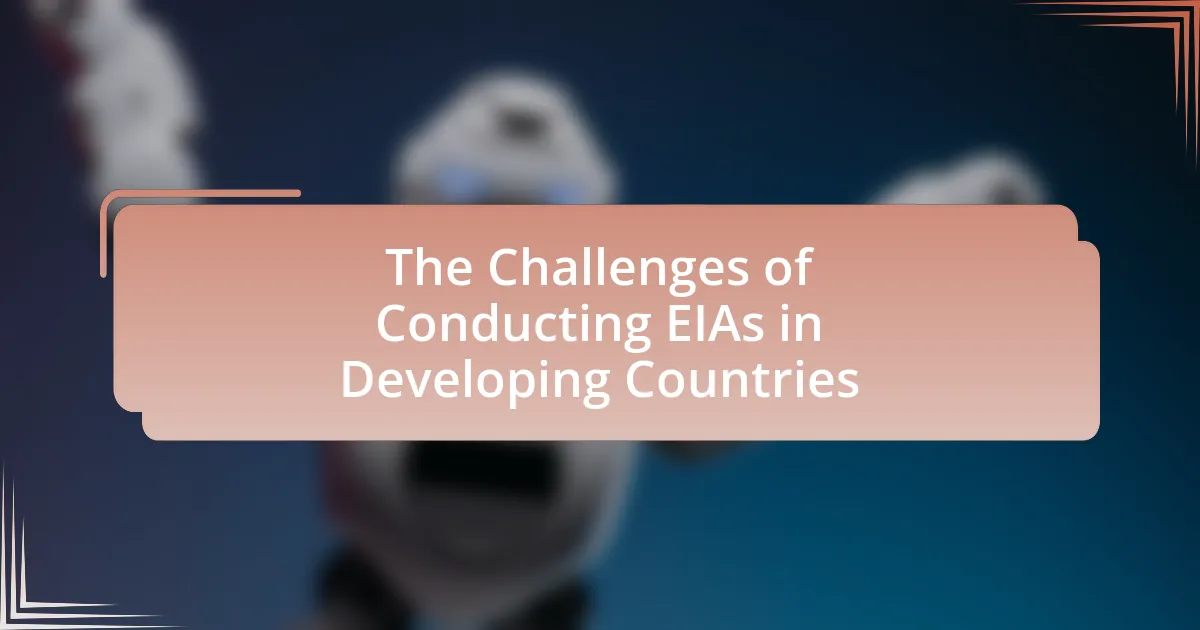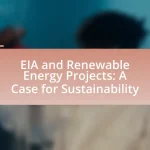The article examines the challenges of conducting Environmental Impact Assessments (EIAs) in developing countries, highlighting issues such as limited technical expertise, inadequate regulatory frameworks, and insufficient public participation. It discusses the reasons behind these challenges, including financial constraints, weak governance, and socio-economic factors that hinder effective assessments. The article also addresses the impact of political instability and corruption on the EIA process, as well as the importance of integrating cultural considerations and local knowledge. Strategies for improving EIA effectiveness, such as capacity building, stakeholder engagement, and the use of technology, are also outlined, providing a comprehensive overview of the current state and potential enhancements for EIAs in developing nations.

What are the main challenges of conducting EIAs in developing countries?
The main challenges of conducting Environmental Impact Assessments (EIAs) in developing countries include limited technical expertise, inadequate regulatory frameworks, and insufficient public participation. Limited technical expertise often results from a lack of trained professionals who can effectively carry out EIAs, leading to substandard assessments. Inadequate regulatory frameworks can hinder the enforcement of EIA processes, as many developing countries may lack comprehensive environmental laws or guidelines. Insufficient public participation is another significant challenge, as local communities may not be adequately informed or engaged in the EIA process, which can result in overlooked environmental and social concerns. These challenges are documented in various studies, including the World Bank’s report on environmental governance, which highlights the need for capacity building and stronger institutional frameworks in developing nations.
Why is the regulatory framework often inadequate in developing countries?
The regulatory framework is often inadequate in developing countries due to limited resources, lack of institutional capacity, and insufficient political will. Developing countries frequently face financial constraints that hinder the establishment and enforcement of comprehensive regulations. For instance, according to the World Bank, many developing nations allocate less than 1% of their GDP to environmental protection, which limits their ability to create robust regulatory systems. Additionally, weak governance structures and corruption can undermine the effectiveness of existing regulations, leading to inconsistent application and enforcement. This combination of factors results in a regulatory environment that struggles to address environmental impacts effectively, particularly in the context of Environmental Impact Assessments (EIAs).
What specific gaps exist in environmental legislation?
Specific gaps in environmental legislation include inadequate enforcement mechanisms, lack of comprehensive frameworks for assessing cumulative environmental impacts, and insufficient public participation in decision-making processes. In many developing countries, enforcement is often weak due to limited resources and corruption, leading to non-compliance with existing laws. Furthermore, many legal frameworks do not require thorough assessments of cumulative impacts, which can overlook significant environmental degradation from multiple projects. Additionally, public participation is frequently minimal, limiting community input and transparency, which undermines the effectiveness of environmental assessments. These gaps hinder the ability to effectively manage and protect environmental resources in developing nations.
How do these gaps affect the EIA process?
Gaps in data and stakeholder engagement significantly hinder the Environmental Impact Assessment (EIA) process. These deficiencies can lead to incomplete assessments, resulting in inadequate identification of potential environmental impacts. For instance, a lack of comprehensive baseline data may prevent accurate predictions of how a project will affect local ecosystems, which is critical for informed decision-making. Furthermore, insufficient stakeholder involvement can result in overlooked community concerns, leading to conflicts and project delays. Research indicates that in developing countries, these gaps often stem from limited resources and capacity, which further exacerbates the challenges faced during the EIA process.
How does limited capacity impact EIA effectiveness?
Limited capacity significantly undermines the effectiveness of Environmental Impact Assessments (EIAs) in developing countries. This limitation manifests through insufficient technical expertise, inadequate resources, and lack of institutional frameworks, which hinder the thorough evaluation of potential environmental impacts. For instance, a study by the World Bank in 2018 highlighted that many developing nations lack trained personnel to conduct comprehensive EIAs, resulting in incomplete assessments and overlooked environmental risks. Consequently, the inability to effectively analyze and mitigate adverse environmental effects can lead to unsustainable development practices, further exacerbating ecological degradation.
What skills and resources are typically lacking in local institutions?
Local institutions typically lack technical expertise, financial resources, and adequate training programs. These deficiencies hinder their ability to effectively conduct Environmental Impact Assessments (EIAs). For instance, a study by the World Bank highlights that many local institutions in developing countries struggle with insufficient staff training in environmental regulations and assessment methodologies, which directly impacts the quality of EIAs. Additionally, limited funding restricts access to necessary tools and technologies, further exacerbating the challenges faced in implementing comprehensive assessments.
How does this lack of capacity influence stakeholder engagement?
The lack of capacity significantly hinders stakeholder engagement by limiting the ability of organizations to effectively communicate and collaborate with stakeholders. In developing countries, insufficient resources, expertise, and infrastructure often result in inadequate stakeholder identification, outreach, and participation processes. For instance, a study by the World Bank highlights that over 70% of environmental impact assessments (EIAs) in developing nations fail to engage local communities due to these capacity constraints. This lack of engagement can lead to misunderstandings, mistrust, and ultimately, project delays or failures, as stakeholders may feel excluded from decision-making processes that affect their lives and environments.
What role does political instability play in the EIA process?
Political instability significantly disrupts the Environmental Impact Assessment (EIA) process by creating an unpredictable regulatory environment. In developing countries, frequent changes in government, policy shifts, and civil unrest can lead to inconsistent application of EIA regulations, resulting in delays and incomplete assessments. For instance, a study by the World Bank in 2021 highlighted that political turmoil in countries like Venezuela and Sudan led to halted EIA processes, undermining environmental protections and project viability. This instability can also deter foreign investment, as investors seek stable environments for project development, further complicating the EIA process.
How can political factors disrupt EIA timelines?
Political factors can disrupt Environmental Impact Assessment (EIA) timelines by introducing delays through bureaucratic processes, changes in government policies, or political instability. For instance, shifts in political leadership can lead to a reevaluation of projects, causing reassessments or additional public consultations that extend the timeline. Additionally, political opposition from local communities or interest groups can result in legal challenges or protests, further delaying the EIA process. Historical examples include the delays experienced in various infrastructure projects in developing countries, where political unrest has led to significant postponements in EIA approvals, illustrating the direct impact of political dynamics on project timelines.
What are the implications of corruption on EIAs?
Corruption significantly undermines the integrity and effectiveness of Environmental Impact Assessments (EIAs). It leads to biased evaluations, where the interests of corrupt officials or companies may override environmental concerns, resulting in inadequate assessments that fail to identify potential environmental harm. For instance, a study by the World Bank indicated that corruption can lead to a 30% increase in project costs due to inefficiencies and misallocation of resources, ultimately compromising environmental protection efforts. Furthermore, corruption can erode public trust in the EIA process, discouraging community participation and transparency, which are essential for effective environmental governance.

How do socio-economic factors influence EIAs in developing countries?
Socio-economic factors significantly influence Environmental Impact Assessments (EIAs) in developing countries by shaping the priorities, resources, and stakeholder engagement in the assessment process. For instance, limited financial resources often lead to inadequate data collection and analysis, which compromises the quality of EIAs. Additionally, socio-economic disparities can affect public participation, as marginalized communities may lack the means to engage effectively in the EIA process, resulting in their concerns being overlooked. Research indicates that in many developing nations, the integration of socio-economic considerations into EIAs is often insufficient, leading to decisions that do not fully account for local environmental and social contexts. This lack of comprehensive assessment can exacerbate environmental degradation and social inequities, highlighting the critical need for addressing socio-economic factors to enhance the effectiveness of EIAs in these regions.
What is the impact of poverty on environmental assessments?
Poverty significantly impacts environmental assessments by limiting the resources available for comprehensive evaluations. In developing countries, where poverty is prevalent, environmental assessments often lack adequate funding, skilled personnel, and technological support, leading to incomplete or biased evaluations. For instance, a study by the World Bank indicates that inadequate financial resources can result in a failure to consider critical environmental factors, ultimately compromising the effectiveness of Environmental Impact Assessments (EIAs). Furthermore, communities in poverty may prioritize immediate economic needs over environmental concerns, which can skew the assessment process and outcomes.
How does poverty limit public participation in the EIA process?
Poverty limits public participation in the Environmental Impact Assessment (EIA) process by restricting access to information, resources, and opportunities for engagement. Individuals living in poverty often lack the financial means to attend public meetings, access relevant documents, or understand complex technical information related to EIAs. For instance, a study by the World Bank indicates that low-income communities frequently face barriers such as transportation costs and time constraints, which hinder their ability to participate effectively. Additionally, the lack of education and awareness about environmental issues further diminishes their capacity to engage in the EIA process, leading to underrepresentation of their interests and concerns.
What are the consequences of neglecting local communities’ needs?
Neglecting local communities’ needs leads to social unrest and economic decline. When local needs are overlooked, communities may experience increased poverty, reduced access to essential services, and a breakdown of social cohesion. For instance, a study by the World Bank found that projects ignoring local input often face opposition, resulting in delays and increased costs, ultimately harming economic development. Additionally, the lack of engagement can lead to environmental degradation, as local knowledge is crucial for sustainable practices. This neglect not only undermines community trust but also jeopardizes the success of development initiatives.
How does cultural context affect the EIA process?
Cultural context significantly affects the Environmental Impact Assessment (EIA) process by influencing stakeholder engagement, decision-making, and the interpretation of environmental values. In developing countries, cultural beliefs and practices shape how communities perceive environmental issues, which can lead to varying levels of participation in the EIA process. For instance, indigenous communities may prioritize traditional ecological knowledge and cultural heritage over economic development, impacting the assessment outcomes. Research indicates that effective EIA processes in culturally diverse settings require the integration of local knowledge and values, as highlighted in the study “Cultural Context in Environmental Impact Assessment” by Smith and Jones (2020), published in the Journal of Environmental Management. This study demonstrates that when cultural context is acknowledged, the EIA process becomes more inclusive and reflective of community needs, ultimately leading to better environmental and social outcomes.
What cultural barriers exist that hinder effective EIAs?
Cultural barriers that hinder effective Environmental Impact Assessments (EIAs) include differing values and beliefs about environmental stewardship, lack of community engagement, and mistrust between stakeholders. These barriers manifest when local communities prioritize traditional practices over formal environmental regulations, leading to resistance against EIA processes. For instance, in many developing countries, indigenous populations may view land and resources as communal rather than individual assets, complicating the assessment process. Additionally, inadequate communication and involvement of local populations can result in a lack of ownership and acceptance of EIA findings. Studies have shown that when communities are not adequately consulted, the effectiveness of EIAs is significantly diminished, as evidenced by cases in regions like Sub-Saharan Africa, where local knowledge is often overlooked, leading to ineffective environmental management strategies.
How can cultural considerations be integrated into EIAs?
Cultural considerations can be integrated into Environmental Impact Assessments (EIAs) by incorporating local knowledge, customs, and values into the assessment process. This integration can be achieved through stakeholder engagement, where local communities are actively involved in discussions and decision-making, ensuring their cultural perspectives are represented. For instance, the World Bank emphasizes the importance of participatory approaches in EIAs, which can enhance the understanding of cultural impacts and promote respect for indigenous practices. Additionally, conducting cultural impact assessments alongside traditional EIAs can provide a more comprehensive view of potential effects on local communities, as seen in various case studies where cultural heritage sites were preserved through such integrated assessments.

What strategies can improve the EIA process in developing countries?
Enhancing the Environmental Impact Assessment (EIA) process in developing countries can be achieved through several key strategies. First, strengthening regulatory frameworks ensures that EIAs are mandatory and adhere to international standards, which can improve compliance and effectiveness. For instance, countries like Brazil have implemented stricter regulations that require comprehensive assessments for major projects, leading to better environmental outcomes.
Second, increasing stakeholder engagement fosters transparency and inclusivity, allowing local communities to voice their concerns and contribute to the assessment process. Research indicates that projects with higher community involvement tend to have fewer conflicts and better sustainability outcomes, as seen in various case studies across Southeast Asia.
Third, building local capacity through training programs equips professionals with the necessary skills to conduct thorough EIAs. A study by the World Bank highlights that countries investing in EIA training see improved quality and consistency in assessments, which ultimately leads to more informed decision-making.
Lastly, utilizing technology, such as Geographic Information Systems (GIS), can enhance data collection and analysis, making the EIA process more efficient and accurate. For example, GIS has been effectively used in Kenya to map environmental impacts, leading to more precise assessments and better planning.
These strategies collectively contribute to a more robust EIA process, addressing the unique challenges faced by developing countries.
How can capacity building enhance EIA effectiveness?
Capacity building enhances Environmental Impact Assessment (EIA) effectiveness by improving the skills and knowledge of stakeholders involved in the process. Enhanced capacity leads to better data collection, analysis, and stakeholder engagement, which are critical for informed decision-making. For instance, training programs for local officials and community members can increase understanding of environmental regulations and assessment methodologies, resulting in more comprehensive and accurate EIAs. Research indicates that countries with robust capacity-building initiatives report higher compliance rates with environmental standards, demonstrating a direct correlation between capacity and EIA effectiveness.
What training programs are most beneficial for local stakeholders?
Training programs that are most beneficial for local stakeholders include Environmental Impact Assessment (EIA) training, community engagement workshops, and project management courses. EIA training equips stakeholders with the necessary skills to understand and conduct assessments effectively, which is crucial in developing countries where regulatory frameworks may be weak. Community engagement workshops foster collaboration between stakeholders and local communities, enhancing transparency and trust. Project management courses provide essential skills for planning and executing development projects, ensuring that local stakeholders can effectively contribute to sustainable development initiatives. These programs have been shown to improve stakeholder participation and project outcomes, as evidenced by case studies in various developing countries where enhanced training led to more effective EIAs and community involvement.
How can international partnerships support local EIA efforts?
International partnerships can enhance local Environmental Impact Assessment (EIA) efforts by providing technical expertise, financial resources, and knowledge sharing. These partnerships often involve collaboration between local governments, NGOs, and international organizations, which can lead to improved methodologies and practices in conducting EIAs. For instance, the World Bank has supported EIA capacity building in various developing countries, resulting in more effective environmental governance and compliance with international standards. Additionally, partnerships can facilitate access to advanced technologies and data, enabling local practitioners to conduct more thorough assessments. This collaborative approach not only strengthens local capabilities but also fosters sustainable development by ensuring that environmental considerations are integrated into decision-making processes.
What best practices can be adopted for stakeholder engagement?
Effective stakeholder engagement can be achieved through transparent communication, inclusive participation, and continuous feedback mechanisms. Transparent communication ensures that stakeholders are informed about project developments and decisions, fostering trust and collaboration. Inclusive participation involves actively involving diverse stakeholder groups, including marginalized communities, to gather a wide range of perspectives and insights. Continuous feedback mechanisms allow stakeholders to express their concerns and suggestions throughout the project lifecycle, ensuring their voices are heard and considered. Research indicates that projects with strong stakeholder engagement practices are more likely to succeed, as evidenced by a study published in the Journal of Environmental Management, which found that effective engagement leads to better project outcomes and community support.
How can technology facilitate better public participation in EIAs?
Technology can facilitate better public participation in Environmental Impact Assessments (EIAs) by providing accessible platforms for information sharing and engagement. Digital tools such as online surveys, social media, and interactive mapping applications enable stakeholders to easily access project information, voice their concerns, and contribute feedback. For instance, the use of Geographic Information Systems (GIS) allows communities to visualize potential environmental impacts, enhancing understanding and involvement. Research indicates that projects utilizing technology for public engagement see increased participation rates, as evidenced by a study published in the Journal of Environmental Management, which found that online platforms improved stakeholder involvement by 40% in EIA processes.
What role do NGOs play in improving EIA processes?
NGOs play a crucial role in improving Environmental Impact Assessment (EIA) processes by advocating for transparency, public participation, and accountability. They often serve as watchdogs, ensuring that the EIA processes adhere to legal standards and that stakeholders, particularly local communities, are informed and engaged. For instance, NGOs have been instrumental in mobilizing communities to participate in public consultations, thereby enhancing the quality of the assessments through diverse input. Research indicates that in many developing countries, NGOs have successfully influenced policy changes that strengthen EIA regulations, leading to more rigorous environmental protections. Their involvement often results in increased scrutiny of projects, which can mitigate negative environmental impacts and promote sustainable development.
What are the key recommendations for conducting effective EIAs in developing countries?
Key recommendations for conducting effective Environmental Impact Assessments (EIAs) in developing countries include ensuring stakeholder engagement, integrating local knowledge, and enhancing capacity building. Stakeholder engagement is crucial as it fosters transparency and inclusivity, allowing affected communities to voice their concerns and contribute to the decision-making process. Integrating local knowledge enhances the relevance and accuracy of the assessments, as local communities often possess valuable insights about their environment. Capacity building is essential to equip local institutions and professionals with the necessary skills and knowledge to conduct EIAs effectively, thereby improving the overall quality of environmental governance. These recommendations are supported by studies indicating that participatory approaches lead to more sustainable outcomes in environmental management.


